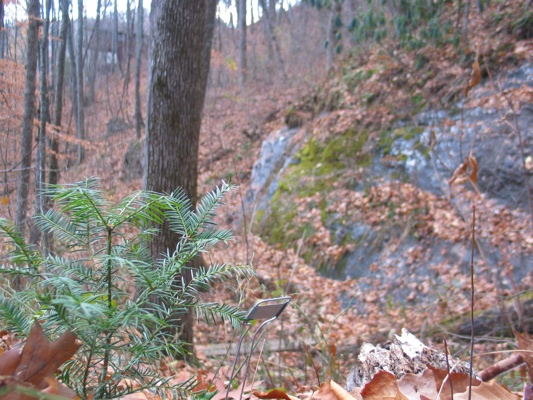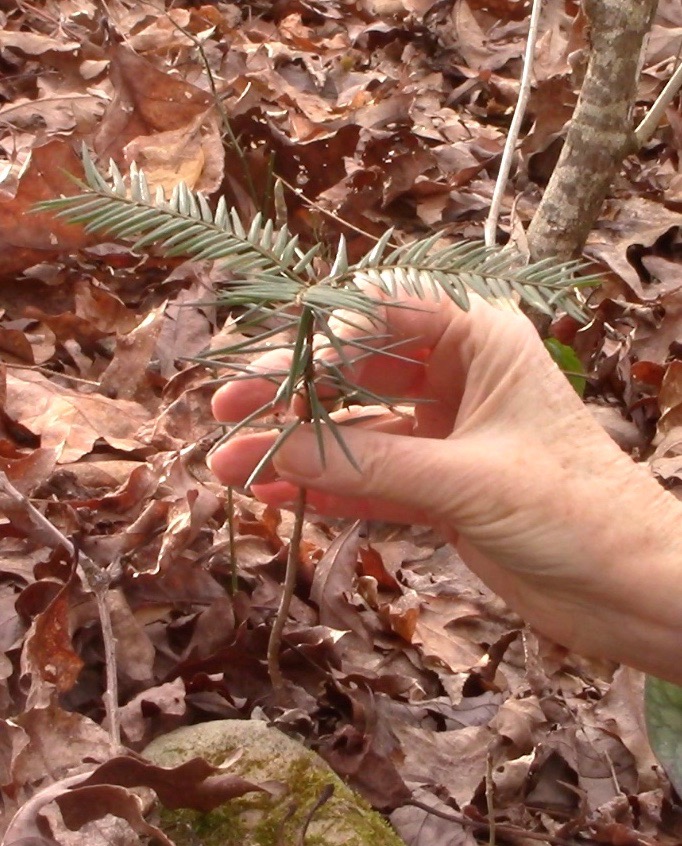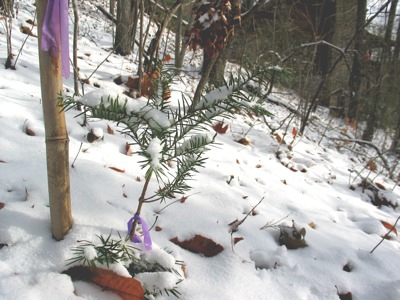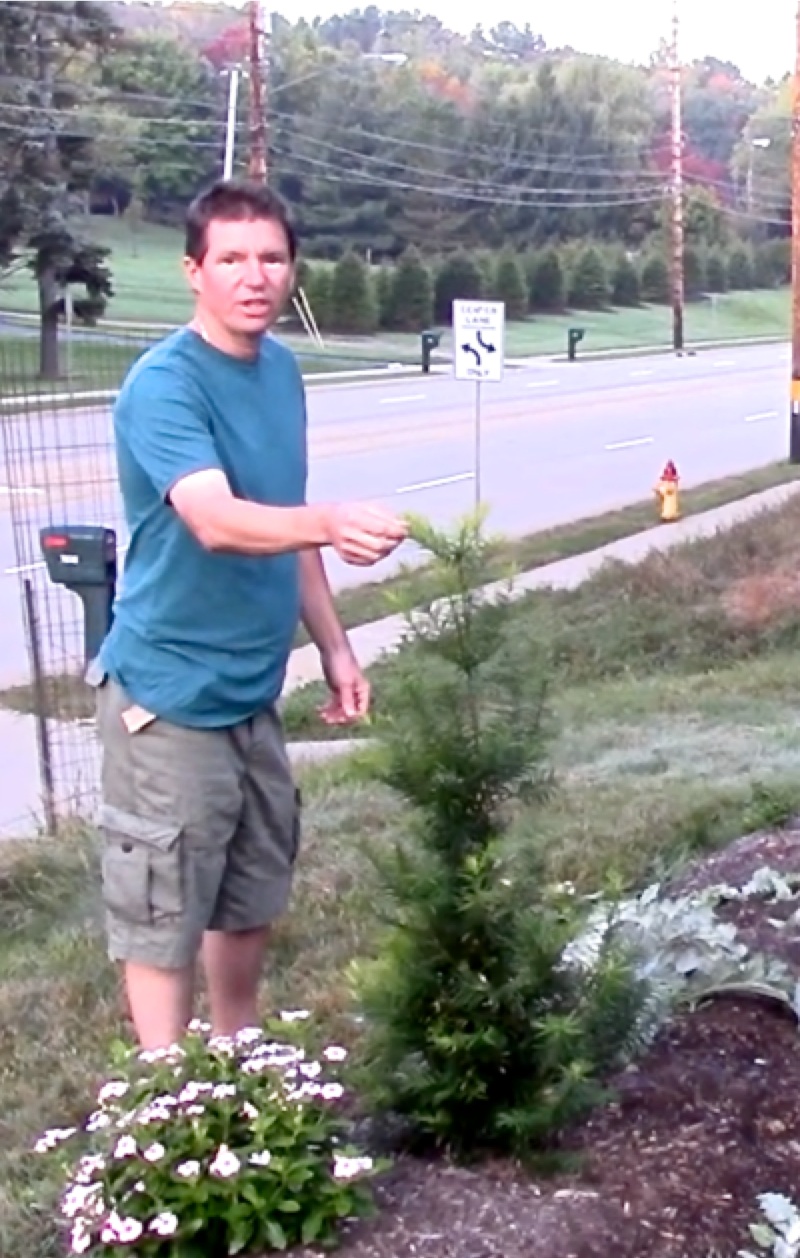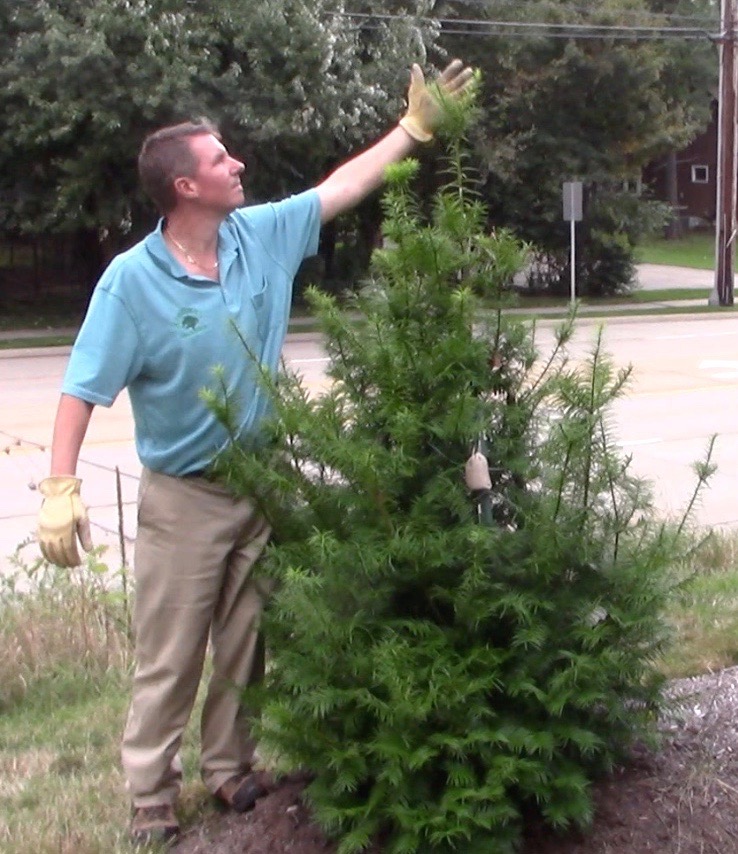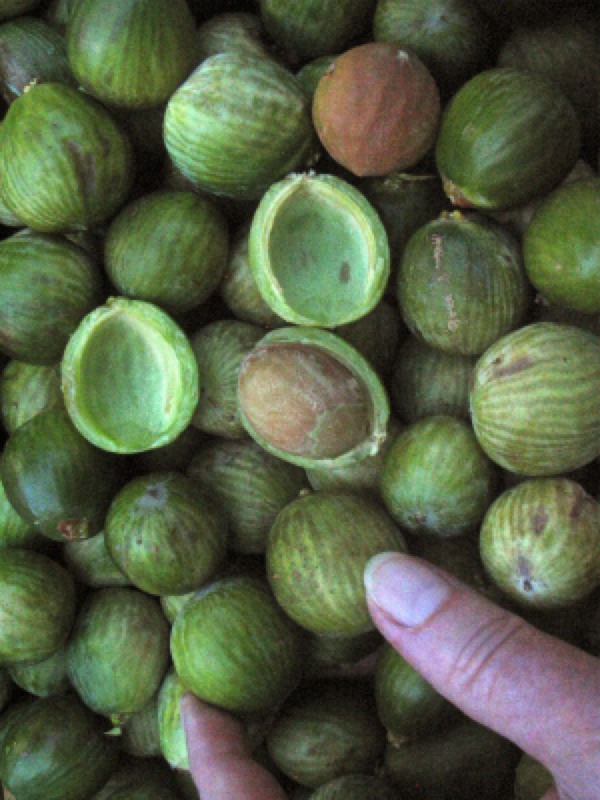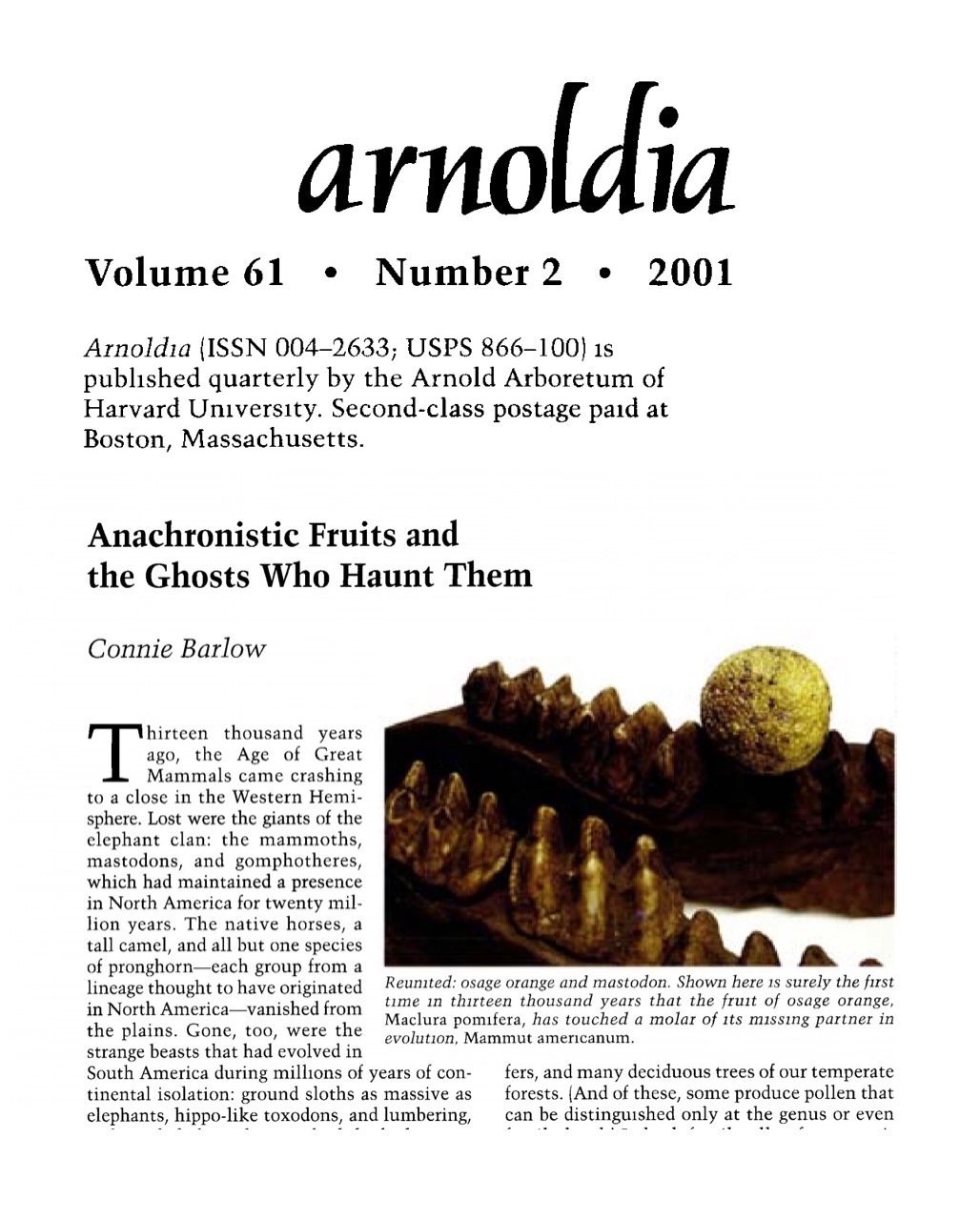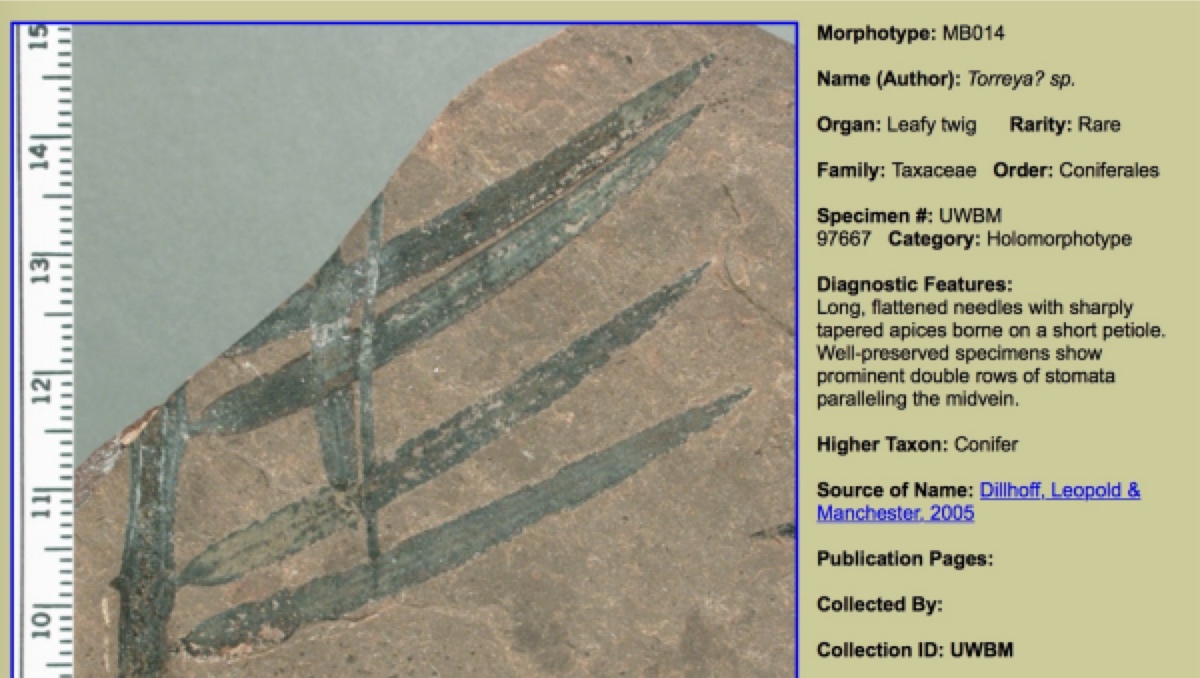Paleoecology and the Assisted Migration Debate:
assembled by Connie Barlow, founder of Torreya Guardians
Why a Deep-Time Perspective Is Vital
Torreya taxifolia as Exemplar
published February 2010 • most recent update July 2023
FLORIDA TORREYA, Torreya taxifolia, has attracted expert botanical attention since it became known to Euro-Americans in the late 1800s. From the beginning, this subcanopy tree has been interpreted as a glacial relict — persisting only in the same small "pocket refuge" it would have occupied during episodes of peak glacial advance in eastern North America. In 1984 it was officially designated as an endangered species.
The extinction plight of Florida torreya was the focus of a pair of papers that effectively launched the "assisted migration" debate.
 |
The papers were published as a pro and con Forum in the Winter 2004/2005 issue of Wild Earth. The paleoecological perspective, which classifies Florida torreya as a glacial relict, was not a topic of dispute: |
The original PRO-assistance essay by Connie Barlow and (the late) Paul S. Martin was titled "Bring Torreya taxifolia North — Now".
Florida torreya's status as a left-behind glacial relict was foundational in the essay that advocated assisted migration. Barlow and Martin wrote:
"... Might it be possible for T. tax to take its place once again as a thriving member of some subset of Appalachian forest communities? We say again because we believe that northern Florida is more properly viewed not as native range for T. tax but as peak-glacial range. Helping T. tax establish in the southern Appalachians is thus not so much relocation for a plant struggling with global warming as repatriation of a once-native. It is a form of rewilding that uses a deep-time baseline for determining appropriate range".The original ANTI-assistance essay by Mark Schwartz was titled "Conservationists Should Not Move Torreya taxifolia." A number of arguments against assisted migration were presented and supported in detail. But the author did not dispute Torreya's status as a glacial relict. Schwartz wrote:
"... Torreya taxifolia is a glacial relict, quite likely on the edge of its climatic tolerance, and might do well in a cooler climate."
THE PROBLEM: LIMITING SPECIES RECOVERY TO "HISTORIC RANGE" IS A FORM OF CLIMATE DENIAL:
The U.S. Fish and Wildlife Service itself, while not disputing the glacial relict status, dismissed its importance in recovery considerations in its 2021 response to a 2019 "Petition to Downlist ..." that Connie Barlow filed (as an individual citizen).
"The loss of an ancestral species' habitat from glaciation is out of the temporal scope of the analyzed historical or current threats acting on the species and is not considered as a criterion that would influence a downlisting decision. [p.4]
"... Additionally, the petition has not provided substantial evidence that would lead a reasonable person to believe that the historical range of T. taxifolia is larger than described at the time the species was listed (Factor A). The petition cited our 1986 Recovery Plan and 2010 5-year review in support of the position that the historical range is larger than described at the time of listing. However, while we acknowledge that the 1986 Recovery Plan and the Service's 2010 5-year review speculate that the geographical range of T. taxifolia, or presumably an ancestral species (i.e. T. antigua), may have, in past geological times, included localities as far north as North Carolina, no native trees have been documented outside of the species' defined current or historical range, and both the Service's 2010 5-year review and the 1986 Recovery Plan confirm that all known native populations occur within four counties in Florida and Georgia." [p.7]
"... The petition and the supporting documentation on the Torreya Guardians webpages provide substantial information regarding the best propagation practices and natural history of the species (Factor E), but the petition did not explain how this information resulted in the reduction or removal of threats to Florida torreya within its native range. The petition also included the locations and conditions of many northern outplantings of Florida torreya; however, the petition further explains that the majority of the documented outplantings are not in locations that would 'give rise to new and expanding populations.' Ultimately, the relative reproductive success of the outplanted groves does not ameliorate the threats currently affecting the species in its historical range (i.e. low population number, rarity of habitat, and disease, USFWS 2010).[p.7]
"... Based on the Service’s 2010 5-year review, the species is considered extremely vulnerable due to its limited range, low population number, and rarity of habitat. The primary decline in species abundance is thought to have resulted from fungal pathogens during the 1950s and 1960s, and/or a combination of environmental stress and native pathogens, but studies have yet to provide an explanation. As a result, the main threat for this species' decline is still not well understood, even though considerable research and management activities have been and are presently conducted on this species.[p.8]
We found that the petition did not present credible scientific and commercial information to support the claim that the destruction, modification, or curtailment of Florida torreya's habitat or range have been ameliorated (Factor A). Additionally, the petition has not provided substantial evidence that would lead a reasonable person to believe that the native range of T. taxifolia is larger than described at the time the species was listed (Factor A). We acknowledge that the petition provided additional documentation on the effects of disease at localities outside of Florida torreya's native range (Factor C), included the locations and conditions of many northern outplantings, and provided new information regarding the species’ natural history and best propagation practices (Factor E); however, the petition did not present information indicating that the primary threats to the species have been reduced or removed. Based on our review of the petition, sources cited in the petition, and other information in our files, we find that the petition does not provide substantial scientific or commercial information indicating that the petitioned action may be warranted." [pp.8-9]
THE INTENT of this skeletal essay is to demonstrate, by using the example of "poster plant" Torreya taxifolia, why the assisted migration debate for THE ENTIRE LIST OF ENDANGERED PLANTS must broaden to encompass a deep-time, paleoecological perspective. Florida Torreya, after all, is not the only species that has been "left behind" in cool-moist ravines, north-facing slopes, and other small topographic sanctuaries when Holocene (and then anthropogenic) warming made their isolation permanent.
THE MOST RECENT (2022) ARGUMENT was made by the founder of Torreya Guardians, Connie Barlow, in the first 16 minutes of this youtube video:
VIDEO Episode 35: Torreya Guardians - Reflections by Connie Barlow, recorded November 2022, includes strong arguments regarding the glacial relict status of Florida Torreya, including the pair of images above.
In the first 16 minutes of this 43-minute video, Barlow advocates that, absent a "deep-time" understanding of the history of this ancient conifer genus, actions taken by institutions officially empowered to control ex situ seed management will "not be grounded in genuine science."
• JULY 2023 NEWS FLASH: Federal government adopts new rule to authorize assisted migration for "experimental populations" of endangered species
In June 2022 the government proposed to modify the ESA regulation (not the statute) so as to no longer require "experimental populations" to be placed within "historical range". I filed a comment (as a citizen) supporting that change, which you can access here. At the same time I went into the Wikipedia page: "Endangered Species Act of 1973" and created a new section titled "Climate adaptation".
"The U.S. Department of Interior on June 30, 2023, announced its decision to modify the section 10(j) "experimental populations" rule generally as proposed a year earlier. The press release summarized the reason for the change as, 'At the time the original 10(j) regulations were established, the potential impact of climate change on species and their habitats was not fully realized, yet in the decades since have become even more dramatic. These revisions will help prevent extinctions and support the recovery of imperiled species by allowing the Service and our partners to implement proactive, conservation-based species introductions to reduce the impacts of climate change and other threats such as invasive species.' The rulemaking action includes a section summarizing 25 topics entailed in comments submitted in 2022, along with the agency's official response to each."
Note by Barlow: My reading of the Federal Register entry and press releases indicates that nowhere is mention made that allowing recovery of endangered plants to take place outside of "historical range" actually constitutes returning the species to its pre-glacial "near-time" or "deep-time" range. Hence, paleoecological evidence and understanding are not reflected in this climate adaptive regulatory change.
FLORIDA TORREYA as CASE STUDY of an endangered GLACIAL RELICT
All three of the earliest federal documents pertaining to endangered species designation and management of Florida torreya contain sections that present a paleoecological understanding of this taxon's relict character as a contributing — possibly ultimate — cause of species decline.
The federal publications are:
(1) 1984 listing of Florida Torreya as endangered
(3) 2010 recovery plan update
The three documents are excerpted below.
• 1984 Federal Register establishment of Torreya taxifolia as endangered:
"An evergreen tree reaching 18 meters tall, Torreya taxifolia (Florida torreya) was first discovered in 1834 and formally described in 1838. The Florida torreya and other endemics of the Apalachicola River system have received much attention from scientists and local residents. The relictual nature of this area accounts for the presence of many unique species (James, 1967).
"During recent glaciations, species migrated southward by way of the Apalachicola River system, which served as a refugium during cooling periods. The Apalachicola River is the only Deep River system that has its headwaters in the southern Appalachian Mountains. With the receding of the glaciers, cool moist conditions persisted on the bluffs and ravines of the Apalachicola River after climatic change rendered the surrounding area much drier and warmer."
• USF&WS 1986 Recovery Plan:
"... Torreya is a genus of four or five species from Florida and Georgia, California, China, and Japan. The present geographic distribution of the genus is similar to the distributions of several other plant genera. The distributions, together with fossil evidence, suggest that these genera had wide distributions during the Tertiary Period that were subsequently reduced by climatic changes during the Quaternary (James 1961, Delcourt and Delcourt 1975). . . It is possible that relatively minor human alterations of the habitat may seriously affect torreya; it is possible that the present-day physical environment of the Apalachicola bluffs and ravines is only marginally suitable to Florida torreya. The species may be restricted to the area because it failed to migrate northward at the end of the Pleistocene."

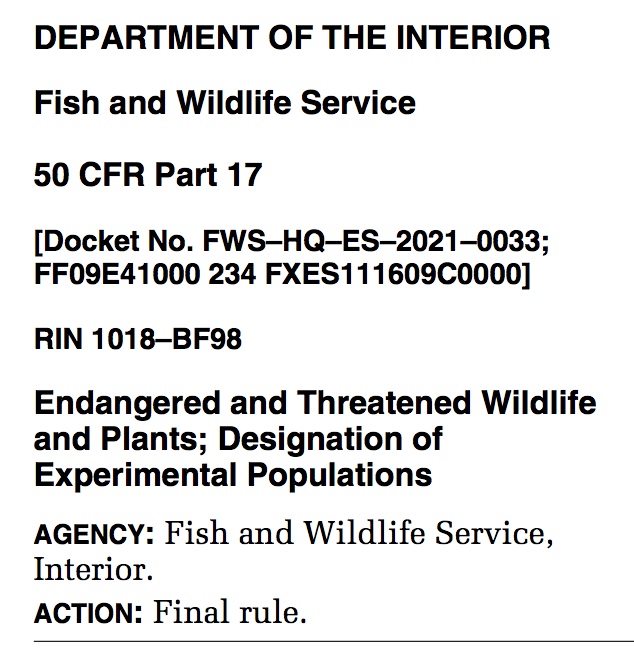
This month, the government finalized the change, so I added this para (with references) to the wikipedia page:
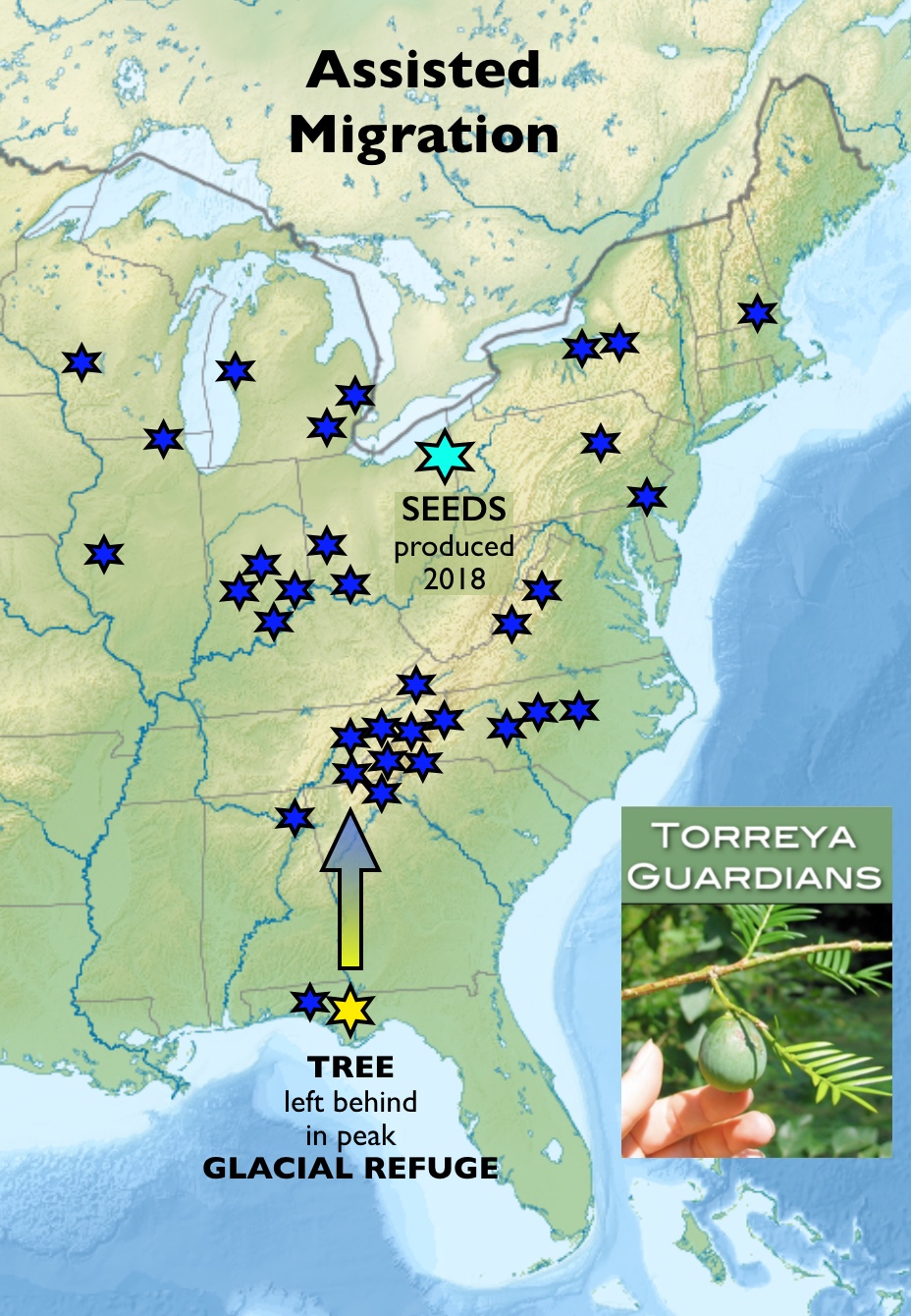
Since the beginning of the debate, the major advocates in favor of assisted migration for Torreya taxifolia have argued that paleoecological reasoning is exceedingly strong in favor of assisting the migration of this highly endangered conifer tree northward from the panhandle of Florida to the southern Appalachians.
__________
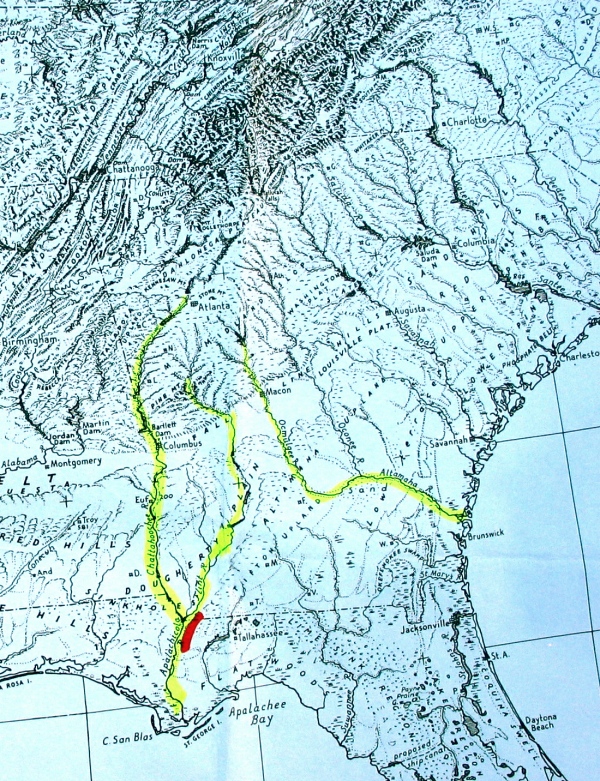
The first paragraph begins:
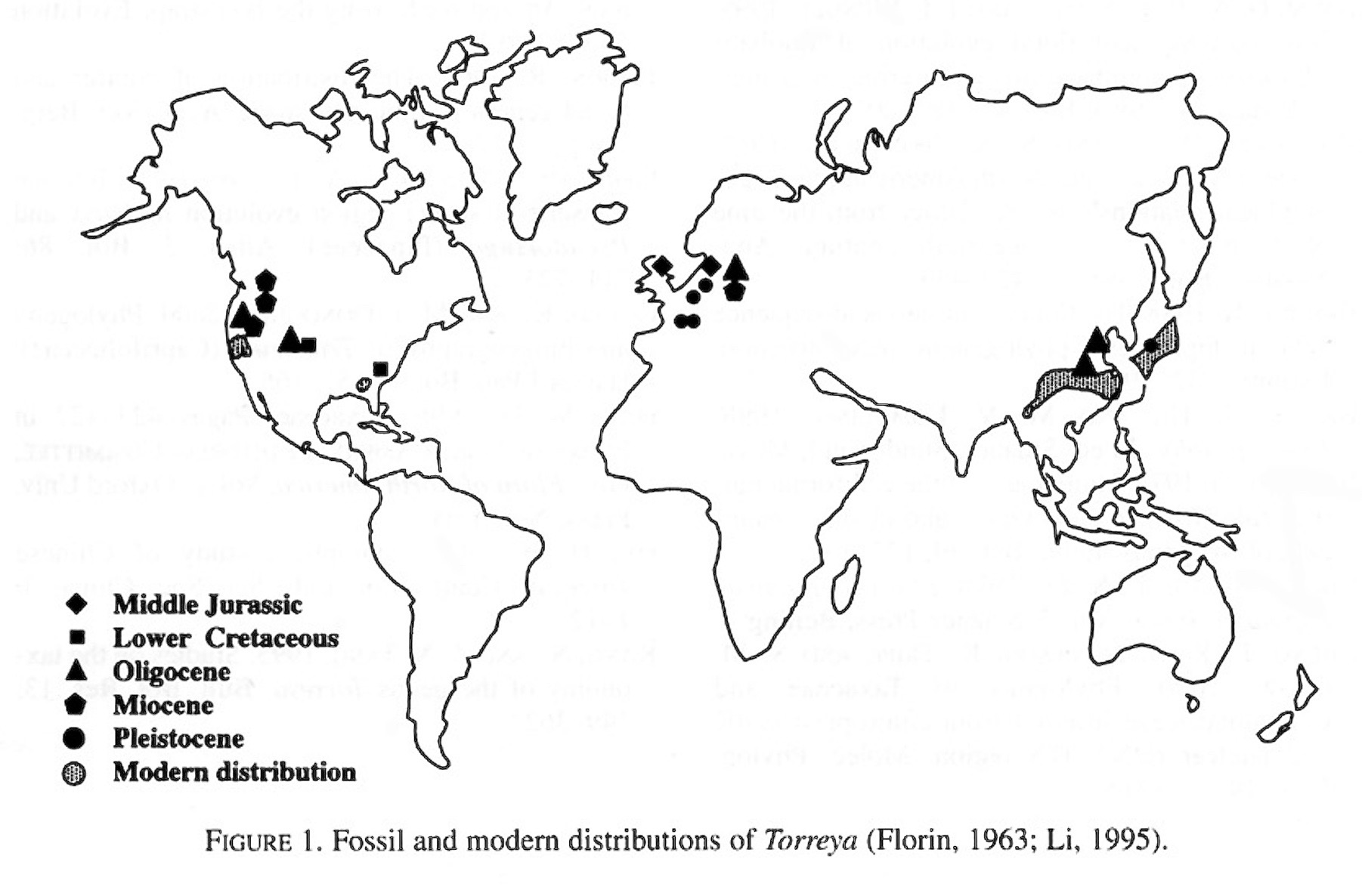
Source: "Phylogenetic Relationships of Torreya (Taxaceae) Inferred from Sequences of Nuclear Ribosomal DNA ITS Region", by Jianhua Li et al., 2001,
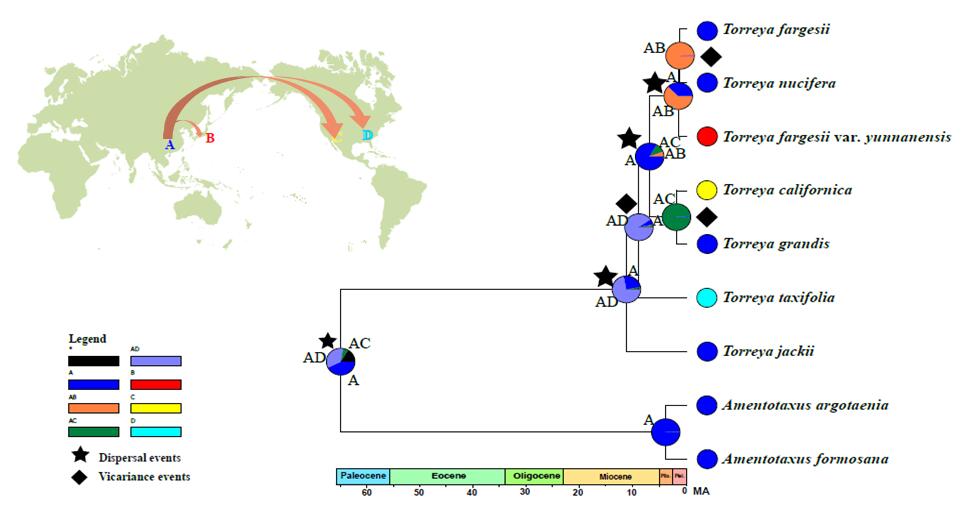
 |
"... Fossil records of Torreya are limited to seeds, leaves, and secondary wood of the Upper Cretaceous (Boeshore and Gray 1936, Chaney 1950). The records indicated that the distribution of the genus in past geological times was much wider than the present distribution. A fossil named T. Antigua, which has some characteristics in common with T. taxifolia and T. californica, was described from the Mid-Cretaceous of North Carolina and was also collected near MacBride's Ford, Georgia (Boeshore and Gray 1936).
"Currently, Florida torreya grows naturally in three counties in Florida: Gadsden, Liberty, and Jackson. It is also found in southern Decatur County, GA, just north of Chattahoochee, FL. Based on fossil records, we can speculate that the geographical range of T. taxifolia included North Carolina and perhaps, it was forced south by glaciers, and when they retreated, it became isolated in small areas of the southeastern United States (p.12, 16).
|
NOTE ON IMAGE ABOVE: Connie Barlow made this image to mark the 3 primary river systems by which floating seeds could swiftly travel southward — and the primary "left behind" tree species associated with each. Because seed dispersal by floating offered no possibility for a return float as climate warmed, glacial relict outcomes would not be a surprise. Critchfield Spruce went extinct. Franklin Tree (Franklinia) was seen and named by the earliest botanists, who carried its seed back to their home in Philadelphia and planted it there. But the tree was never again seen in its discovery site near the mouth of the Altamaha River. A recent attempt by The Nature Conservancy to restore horticulturally grown Franklin seeds in New England to its peak glacial refuge ended in failure.
TWO BOTANICAL PUBLICATIONS IN 1905 concluded that Torreya taxifolia is a glacial relict:
• Cowles 1905: "... It seems likely, then that we should regard Torreya taxifolia as a northern mesophytic left stranded to-day only in Florida. It presumably is one of the plants that failed to follow up the last retreat of the Pleistocene ice, and is preserved here perhaps because of exceptionally favorable topographic conditions."
2010 PAPER in the field of plant biogeography points to Florida Torreya as an example of "species migrational lag":
• "Disequilibrium Vegetation Dynamics Under Future Climate Change":
CONNIE BARLOW'S FIELD EXPERIENCE and PUBLICATIONS of Torreya's relict status
BEGINNINGS OF AN IDEA (1999): On a visit to Torreya State Park in quest of "ecological anachronisms" during field research for her 4th published book, science writer Connie Barlow encountered the stragglers of Florida Torreya still in the park, along with pickled Torreya seeds in the park office. This venture is described, and translocation advocacy initiated, in her 2001 book and 2001 Arnoldia article:
• The Ghosts of Evolution: Nonsensical Fruit, Missing Partners, and Other Ecological Anachronisms, by Connie Barlow, 2001 (Basic Books)
If gardening a few local patches of endangered plants is tough today, it's going to get a lot tougher when, like it or not, we become gardeners of the planet. Helping plants track climate change from one patch of forest to another will be a routine tactic for conserving biodiversity decades hence. Is it too early to begin now with Florida torreya?
• "Anachronistic Fruits and the Ghosts Who Haunt Them", by Connie Barlow, 2001, Arnoldia pp. 14-21. (Also via Researchgate.)
Note by Barlow on the genesis and intent of this article:
EXCERPTS: "... The proximate cause of Torreya taxifolia's imminent extinction, and thus the cause that gets all the attention, is disease. Some thirty pathogens are known to infest it, but no single disease seems to be the culprit....
"... Squirrels that fed on torreya seeds on the east side of the river would be unable to carry them across water to the west side, and if the rich soils of the Apalachicola are isolated from rich soils to the north by a barrier of sandy soils, then the squirrels would also be unable to disperse the seeds farther north. Squirrels may thus be a disperser, but they apparently are not the right disperser for helping this tree
reclaim its pre-glacial range. This explanation would account for the seemingly paradoxical fact that until the 1950s, Florida torreya was the
seventh most abundant tree species in an astonishingly small patch of 'native' habitat.
"For a number of years, Alexander had been thinking that 'Florida' torreya really belonged back in North Carolina. So he was delighted to hear of the lost disperser theory. A megafaunal ghost? If so, the ghost may well be a large extinct tortoise, I suggested, as reptiles are far more tolerant of plant terpenes than are mammals, and as the thin 'shell' protecting the large single seed of this conifer offers scant protection against molars.
"Bill Alexander and I easily came up with two plausible explanations for the differences in endangerment, based strictly on geographic differences. In eastern North America, the climatic effects of the Ice Sheet reached much farther south than was the case in either western North America or eastern Asia, forcing the Appalachian species to take refuge at a lower latitude.
"Perhaps even more significant is that latitudinal migration was the only option for Florida torreya as the climate warmed. In contrast, torreya species in California and in Asia could head upslope. These torreyas are native to mountainous regions, where altitudinal gain facilitated by nothing more than squirrels could help the trees keep pace with a
warming climate.
"Such unsubstantiated and untested leaps of speculation are normally not well received within the scientific community — but these are
not normal times. Without some drastic breakthrough in the management of Florida's wild population of torreya trees, Torreya taxifolia
will, within fifty years, almost surely be extinct outside of botanical gardens.
"Perhaps it is time to help this torreya gain rootholds of wild populations in the mountains of North Carolina.
"Such is not, alas, how things are done with endangered species — the exception being the recent return of the California condor to its
Pleistocene home near the Grand Canyon. Native territory is regarded as the last best place to be. But what is 'native'? How far might we justifiably reach back in time for a benchmark? In a study of endangered species published in 2000, Rob Channell and Mark Lomolino concluded that 'most species examined persist in the periphery of their historical geographic ranges.' If habitat at the periphery of historical range is adequate but not ideal, then the last place a troubled species is found may not, in fact, be the best place to assist its recovery.
"Transplantation across great distances is an uncommon and controversial technique for biodiversity conservation today. But as the greenhouse effect ratchets up temperatures and reroutes rainfall, and as botanical preserves become even more isolated islands in a sea of human development, long-distance transplantation will become the norm. If gardening a few local patches of endangered plants is tough today, it's going to get a lot tougher when, like it or not, we become gardeners of the planet [citation Daniel Janzen, 1998, "Gardenification of wildland nature and the human footprint".] Helping plants track climate change
from one patch of habitat to another will be
a routine tactic for conserving biodiversity
decades hence. Is it too early to begin now with
Florida torreya?"
PALEOECOLOGIST HAZEL DELCOURT'S ROLE in motivating assisted migration for Torreya
BOOK BY U. TENN PALYNOLOGIST LINKS EASTERN FOREST PALEOECOLOGY WITH GLOBAL WARMING (2002): Connie Barlow read this book upon publication. Thanks to that reading, Connie's concern for Torreya taxifolia ramped up into a commitment to act.
• Forests in Peril: Tracking Deciduous Trees from Ice Age Refuges into the Greenhouse World, by Hazel Delcourt, 2002
... We can provide corridors to allow for species to migrate successfully in the face of climate change. We may also need to be prepared to transplant endangered species to new locations where climate will be favorable." (p. 207)
Note: Delcourt's papers are cited in the 1986 recovery plan for Florida Torreya.
A BOOK REVIEW by Connie Barlow was published in a 2004 issue of Wild Earth.
Note: An additional 2008 review by Connie Barlow of Forests in Peril, posted on Amazon, documents that this book played a pivotal role in the formation of Torreya Guardians: NOTES FROM BARLOW'S 2004 VISIT TO HAZEL DELCOURT:
The point here is: Since we can all agree that the Apalachicola did indeed serve as a peak glacial refuge, we should at least entertain the possibility that any species that is strangely endemic there might have as the primary reason for its endemism the fact that it is a glacial relict. This line of reasoning would also apply to the endemic Florida yew, Taxus floridana. In contrast, no one would look at the remnant American beech population that is still holding on along the Apalachicola River and declare that it is best adapted for exactly the climatic conditions now found there. Indeed, Hazel Delcourt has advocated that this southernmost population of American beech may well contain warm-adapted alleles that will prove vital for ensuring continued representation of this species in the Appalachians and points north a century hence (pers. comm.). A superbly detailed photo-essay of the largest trees in the lowlands of Torreya State Park is accessible here. Although the author never mentions Torreya, nor seems aware of the park's status as a peak glacial refuge, he offers helpful details on the sizes of tree species now common in the S. Appalachians: Tuliptree (Liriodendron), American Beech, Sweetgum.
Argument 1. WHY FOSSIL EVIDENCE IS SPARSE in eastern USA
Torreya is a very ancient conifer genus, represented today by a half-dozen species and a globally disjunct range characteristic of many plants affected by the Oligocene cooling and consequent break-up of what had been a globally connected Arcto-Tertiary Geoflora. Further displacement and outright extinctions of Torreya populations and species occurred when the Pleistocene glaciations forced populations to move southward yet again.
Here you can see that, while Europe lost its Torreya species during the Pleistocene, it has a rich fossil record of this genus extending back to the middle Jurassic.
Today the genus is represented by one species in Florida, one in California, and four or five in Japan, Korea, and eastern China.
The map above is included in "Phylogenetic Relationships of Torreya (Taxaceae) Inferred from Sequences of Nuclear Ribosomal DNA", 2001, by Jianhua Li et al. The only fossil evidence of genus Torreya in eastern North America comes from the Cretaceous in what is now North Carolina and Georgia. However, Genus Torreya is well represented in the fossil record of western North America in many geological time blocks. Here is why:
1A. MACROFOSSILS of plants can be superbly preserved in the ashfall from volcanic eruptions. Cenozoic leaf and cone fossils of any species are not, however, well represented in the tectonically placid Appalachian region. In contrast, see below the excellent detail of a Torreya fossil from the McAbee Flora, Eocene, of British Columbia. 1B. MICROFOSSILS of genus Torreya are simply unavailable. As paleoecologist Paul S. Martin explained in the Barlow and Martin 2004 torreya advocacy paper, Torreya pollen is indistinguishable from the pollen of yews (Taxus), bald cypress (Taxodium), and cypress (Cupressus). Hence, it is scientifically naive to point to a lack of microfossil evidence in the Appalachians as evidence against the genus having been there.
1C. CENTER FOR PLANT CONSERVATION description of the Paleogeography of Genus Torreya:
Argument 2. ABSENCE OF EVIDENCE IS NOT EVIDENCE OF ABSENCE
Given the paucity of macrofossils in the tectonically ancient Appalachian Mountains, plus the indistinguishable pollen of Torreya, it is scientifically naive to insist that one must find direct evidence of genus Torreya inhabiting the southern Appalachians during the Pleistocene (indeed, during any time of the Cenozoic) in order for Torreya Guardians or others to responsibly posit that the southern Appalachians were previously part of the species' native range. Such insistance is, rather, evidence of the claimant's ignorance of regional geology and the limits of palynological tools for using pollen to distinguish genera within families Taxaceae and Cupressaceae.
Argument 3. PREFERRED RANGE TO THE NORTH
Unless it can be established that a particular introduced disease agent is the sole cause of the inability of almost all wild Torreya individuals to reproduce in the range it occupied in 1491 (which is the implicit standard for ecological restoration activities in the USA), then we need to consider the strong possibility that inability to thrive is a sign that Holocene (plus anthropogenic) climate warming hit a tipping point for the species back in the 1950s and 1960s (when this once-common Apalachicola species suddenly became uncommon and non-reproductive).
Thankfully, some horticulture plantings of Florida torreya in northward states are mature and reproductive. None bear signs of the degree of disease pathology that consistently knocks back stem growth of this species in Florida. Torreya Guardians has documented these mature groves and evidence of full "naturalization" (ability to seed and for those seeds to naturally sprout and establish in the surrounds with no human assistance) at this 2018 webpage: "Historic Groves of Torreya Trees: Long-term Experiments in Assisted Migration".
ABOVE: Torreya Guardians photos of seed-gathering events at three private locations in North Carolina. Left to right: Mt. Olive, Clinton, and Highlands.
Argument 4. FLORIDA COULD NOT HAVE BEEN ETERNALLY NATIVE RANGE
Indeed, as evident in the maps, Florida was underwater during warm episodes of the Cenozoic.
Maps: "The Cenozoic Timescale and Paleogeography". Credit: Dr. Ron Blakey and Deep Time Maps.
The most parsimonious interpretation is that genus Torreya remained in the Appalachians throughout the Cenozoic until the stark cooling of the Pleistocene forced southward migration.
Argument 5. TORREYA IS A MOUNTAIN-ADAPTED GENUS
For whatever reason (perhaps because its large seed means that it disperses only very slowly) the other four or five species of Torreya all exist in the wild today only in mountainous regions of Asia and California. T. taxifolia is the outlier species, in that it lives nowhere near any mountains. But could that be because it was forced to retreat in glacial times far south of its mountain habitat and simply failed to make the return migration? After all, mountain species can react to climate change much more quickly by curving around a mountain between northern and southern exposures, and by moving altitudinally higher or lower. For a visual tour and narration of the extraordinary steep-slope abilities of Torreya californica in small, rare, disjunct populations on the slopes of California's Coast Range and the western slope of the Sierra Mountains, watch this 2018 video (by Connie Barlow): "Florida Torreya's California Cousin Has Clues for Ex Situ Plantings".
Note: A 2023 publication in the journal Rhodora reporting on the May 2022 meeting of the New England Botanical Society included this statement pertaining to the general botanical understanding of the relictual status of Torreya taxifolia:
Argument 6. POSSIBLE CAUSES OF WHY TORREYA NEVER RETURNED NORTH
6A. Perhaps T. taxifolia did successfully migrate back and forth between the Apalachicola and the Appalachians throughout previous climate cycles in the Pleistocene — but the arrival of humans in the Holocene interglacial period became an obstacle. Paul S. Martin in 2004 posited that fire-setting by humans could have disrupted forest continuity along the river corridor. Connie Barlow in 2004 suggested that over-hunting of squirrels (the current dispersal agent) by first peoples settled along the Apalachicola River could have contributed, or perhaps over-hunting of a large tortoise species that might also have distributed seeds. The wikipedia entry on Torreya taxifolia cites Connie Barlow's "evolutionary anachronisms" paper as positing an extinct tortoise or other reptilian disperser.
But there was no river-flow way to return north during any of the interglacial warmings.
In the first half of the 20th century, the add-on of human-caused warming apparently surmounted the physiological threshold of genus Torreya. Florida Torreya was no longer able to ward off more than a half-dozen native diseases. The fact that the Florida Yew, Taxus floridana is also a subcanopy rare endemic limited to the same relictual range as Florida Torreya suggests that river-flow assistance may truly be limiting. After all, the seed of Florida Yew is bird-dispersed; dispersal by birds offers faster and greater long-distance distribution than can squirrels or tortoises.
Argument 7. A PALEOECOLOGICAL PERSPECTIVE SHIFTS THE BURDEN OF PROOF
I regard all the forgoing arguments not only as scientifically reasonable, but as scientifically necessary. We cannot simply look to where plants were in the year 1491 as the sole, nor even the best, standard for where native range was in millennia past — and where preferred and perhaps required range will likely be in the not-too-distant future. Surely, one cannot serve the interests of this endangered species in a time of rapid climate change without taking a deep-time (that is, paleoecological) perspective. Until a significant minority of botanists and ecologists make the shift to a deep-time perspective, however, those of us advocating assisted migration northward will continue to face an uphill battle.
2017 ADDENDUM: "Conservation Paleobiology" is now an accepted facet of conservation biology efforts in this century of rapid climate change. In recent years, critiques of "assisted migration" and the actions of Torreya Guardians have virtually disappeared, while a new term enters the conservation lexicon. See "Conservation Paleobiology: Leveraging Knowledge of the Past to Inform Conservation and Restoration", by Gregory P. Dietl et al., 2015, Annual Review of Earth and Planetary Sciences and a USA National Park Service report: Making the Transition to the Third Era of Natural Resources Management by Nathan L. Stephenson, 1916, The National Park Service Centennial Essay Series.
2019 ADDENDUM: A 2019 paper by (University of Michigan) paleontologist Philip D. Gingerich puts the scale and rapidity of human-caused global warming into deep-time context — that is, comparing the combination of magnitude and speed happening in current centuries against the greatest warming that occurred during the entire 65 million-year Cenozoic Era. Prior to our anthropogenic warming, the most challenging warming episode was 56 million years ago. This was the "PETM" (Paleoecene-Eocene thermal maximum). Gingerich concludes that the evidence suggests that our species is now causing an even more rapid warming: "If the present trend of anthropogenic emissions continues, we can expect to reach a PETM-scale accumulation of atmospheric carbon in as few as 140 to 259 years (about 5 to 10 human generations)." In: "Temporal Scaling of Carbon Emission and Accumulation Rates: Modern Anthropogenic Emissions Compared to Estimates of PETM-Onset Accumulation"
8A. PUTTING TO REST THE "INVASIVE PLANT" BOGEYMAN FOR INTRA-CONTINENTAL N-S ASSISTED MIGRATION
It is widely recognized that Torreya taxifolia is the "poster plant" for assisted migration advocates in the USA because (a) it no longer reproduces in its "native" range, and (b) no one who knows this plant could responsibly argue that this species poses an ecological threat if moved northward. More generally for all native species that will be needing help moving north, a key paper published in 2007 concludes that north-south translocations of land-plant species within a continent pose very little risk of invasion. This paper should be required reading for all participants in the assisted migration debate:
8B. UPDATE JUNE 2021: STOP USING THE TERM "NEO-NATIVE."
Owing to an April 2021 paper by Brodie et al. in the prestigious journal Science and its use of the contentious term "neo-native", I recommend that commentators on this topic familiarize themselves with the set of terms for range distinctions (historical, near-time, and deep-time) that Paul S. Martin and I included in our 2004 draft annotated list of "Standards". This list was originally intended as a sidebar in our advocacy essay published in Wild Earth, "Bring Torreya taxifolia North Now". Owing to space limitations, the journal could not print the List of Standards, but I posted the list here on the Torreya Guardians website. Rereading the draft in 2021, I call attention to our summary of past range reconstruction, and now suggest that, when referring to poleward translocations on the same continent, the adjectives "historical, near-time, and deep-time" also be used to modify the noun "native." For example, Florida Torreya qualifies as both a "near-time" and a "deep-time" native of the southern Appalachian mountains. It is not a neo-native. Here is the original explanation Paul and I offered in 2004:
Argument 9. USING ASSISTED MIGRATION TO "FREEZE OUT" THE PATHOGENS HARMING TORREYA TAXIFOLIA IN ITS FLORIDA RANGE.
9A. FREEZING OUT PHYTHOPHTHORA. Torreya Guardian Russell Regnery also participates in the American Chestnut Foundation effort to cross-breed American with Asian Chestnut in order to eventually produce a species with only the minimal Asian genes necessary to withstand the exotic chestnut blight disease agent here in America. In a February 2011 email, he writes (pers. comm.):
9B. FREEZING OUT FUSARIUM. Beginning in 2010, Prof. Jason Smith of the forest pathology program at the University of Florida, set about identifying the genetics of the Fusarium species that causes stem cankers on the Torreya taxifolia plants in Florida. It is still an open question as to whether this newly named Fusarium torreyae is a recently imported exotic from Asia. The 2016 multi-author paper states: "... it remains to be determined whether F. torreyae is native to North America and restricted to T. taxifolia."
AN INVITATION TO BEGIN ASSESSMENT OF THE EXISTING SPECIMENS OF T. TAXIFOLIA IN NORTH CAROLINA AS THE FIRST PHASE OF A PILOT PROJECT TESTING THE MERITS OF ASSISTED MIGRATION.
The 2010 revisions to the Endangered Species management plan for Torreya taxifolia state:
Although the revised plan does not specifically call for a pilot project, it doesn't prohibit team members from initiating one. We at Torreya Guardians have done the work to pinpoint the existing Torreyas found in North Carolina and are happy to share that information with those working in accordance with the ESA. In addition to visiting the existing mature specimens that private individuals planted nearly a century ago, we keep excellent records of our own plantings that began in earnest in 2008. Meanwhile, Atlanta Botanical Garden has an abundance of healthy little seedlings with nowhere, really, to go. (See for example, a photo-essay of a site visit Torreya Guardians made to Atlanta Botanical Garden to learn best how to propagate and nurture this species.)
"ASSISTED MIGRATION" — NOT "ASSISTED COLONIZATION"
Two supplementary webpages speak to the (a) history of the terminology discussion (which began with "assisted migration" and then moved to "assisted colonization"), and then (b) a 2011 advocacy piece by Torreya Guardian Connie Barlow on why "assisted migration" should be restored as the term of use. Barlow writes:
UPDATE 2021: While academics and their peer-reviewed papers continue to regard Florida Torreya as a glacial relict, this point is omitted from recent governmental publications and from apparently all written records and statements provided to media by the two botanical gardens in Georgia undertaking the official recovery actions for this listed endangered plant.
Presentation of this recent problem is given in Connie Barlow's 2021 "Case Study: Agency and Institutional Failures in Endangered Species Management of Florida Torreya". (Points 1, 2, and 13 within this document address the glacial relict discordance.)
— Hazel Delcourt
"There is a rabbinical teaching that says, if the world is ending and the Messiah arrives,
— Paul Hawken
• Williams and Dumroese, 2013, "Growing Assisted Migration: Synthesis of a Climate Change Adaptation Strategy", USDA Forest Service Proceedings, RMRS-P-69: "... The only known assisted migration program in the U.S. is a grassroots effort to save Torreya taxifolia (Florida torreya), a southeastern evergreen conifer, from extinction (McLachlan and others 2007; Barlow 2011)."
• Iverson and Taft, 2022, "Past, Present, and Possible Future Trends with Climate Change in Illinois Forests", Erigenia 28, pp 53-70: "... Assisted migration, or the introduction of a species outside its native range (McLachland et al. 2007), has been suggested for selected species of conservation concern (Barlow 2011) as a hedge against extinction resulting from climate change (Schwartz et al. 2012), but also to enhance survival of tree species not necessarily at risk of extinction (Pedlar et al. 2012; Iverson and McKenzie 2013; Williams and Dumroese 2013; Handler et al. 2018)."
Return to HOME PAGE
Could Torreya Take the Place of Eastern Hemlock?
Annotated List of Papers/Reports Online re Assisted Migration
Florida Torreya survived the Holocene warming in its peak glacial reserve in the Florida portion the Chattahoochee River system, but human-caused additional warming made it vulnerable to a number of diseases, such that it pretty much stopped producing seeds by the 1960s. (Notably, Torreya Guardians achieved seed production beginning in 2017 at one of its "assisted migration" plantings in Ohio.)
__________
• Coulter and Land 1905: "... "The conclusion is irresistible that Torreya is a northern plant of the most pronounced mesophytic tendencies, and to be associated with such forms as the beech-maple-hemlock forms of our northern woods, our most mesophytic type of association."
__________
"... For example, Torreya taxifolia Arn. has experienced, range-wide decline, which may be due to lagged responses to climate change (Barlow and Martin, 2005)."
— Jens-Christian Svenning and Brody Sandel, 2013, American Journal of Botany, "Special Invited Article."
EXCERPT (pp. 229-231): ... In a study of endangered species published in 2000, Rob Channell and Mark Lomolino concluded that "most species examined persist in the periphery of their historical geographic ranges." The implication is that the last place a troubled species is found may not, in fact, be the best place to assist its recovery. Transplantation is an uncommon and controversial technique for biodiversity conservation today. But after the greenhouse effect has ratcheted up temperatures and rerouted rainfall, it surely will become the norm. Arnoldia editor Peter del Tredici asked me to write this article, which focuses far more on the fruit characteristics and paleohistory of genus Torrreya than does the 2004 paper by Barlow and Martin, which is the most cited. The last section of this article, pages 19-21, present an exclusive focus on torreya.
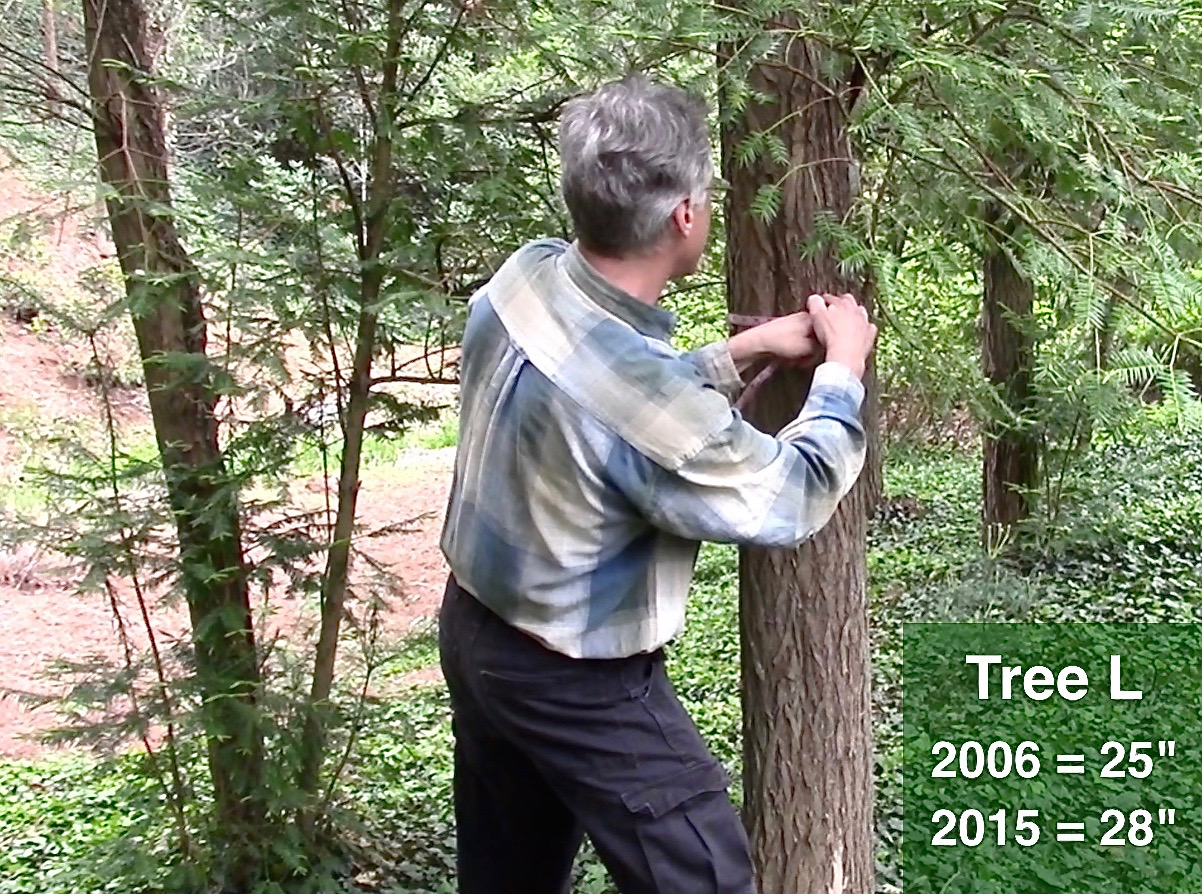
Three stems visible; leftmost may be an offspring.
"Perhaps the best evidence that Florida torreya may be suffering from an inability to track climate change is that before the blight took hold, this tree was planted hundreds of miles north of its Florida habitat in the mountains of North Carolina, near Asheville. There, on the Biltmore Estate, the torreyas are thriving, and the females produce abundant seeds. 'Flower beds often abound with seedlings planted by squirrels,' reports Bill Alexander, landscape historian at the Biltmore. During his 23 years there, Alexander has watched the torreyas stand up well to a five-year drought. And in the winter of 1985 the thermometer plunged to minus-20 degrees Fahrenheit, yet 'our trees smiled right through,' he told me.
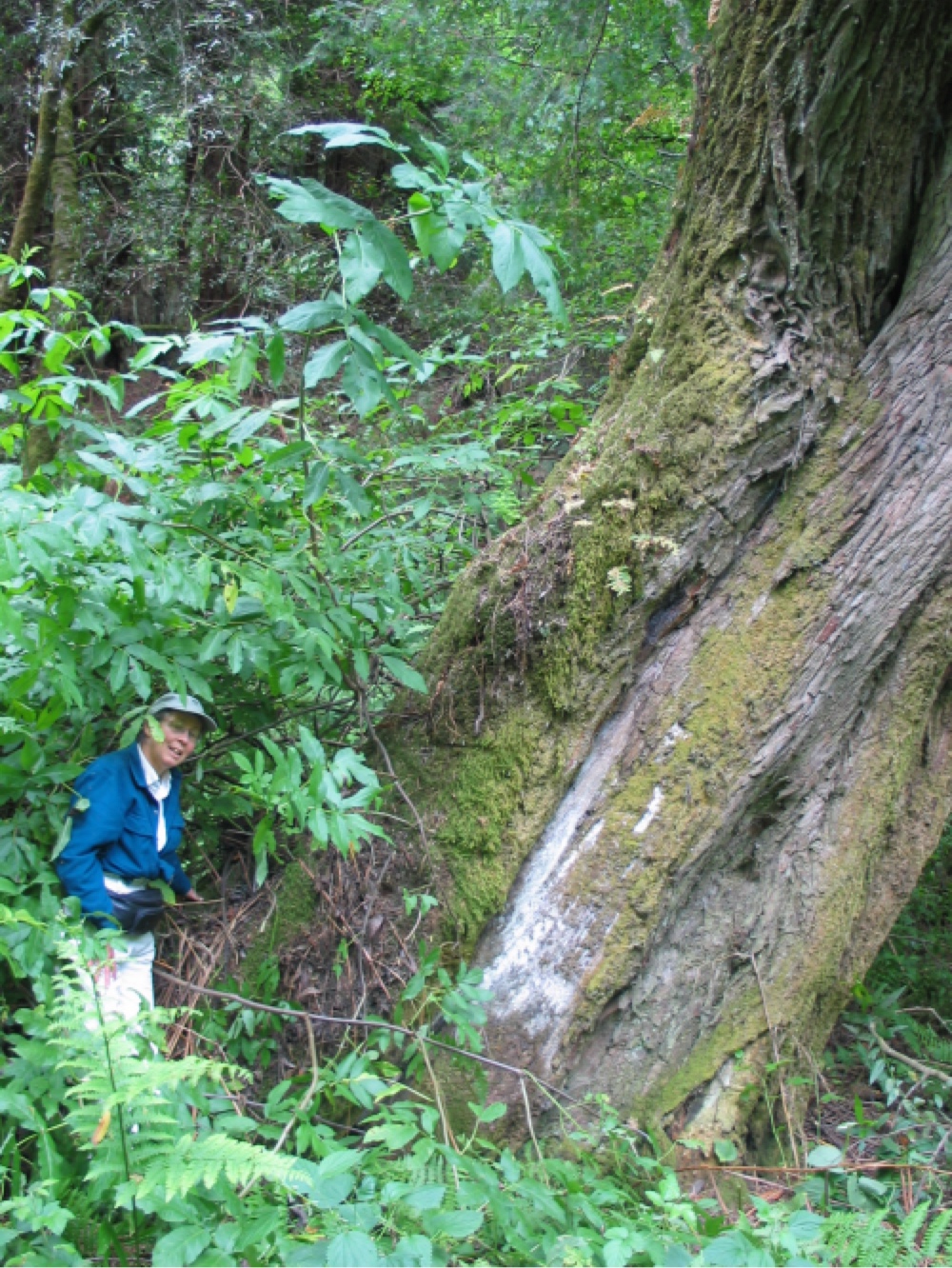
California Torreyas north of Santa Cruz.
"One must not, however, ponder the plight of the Florida torreya in isolation from its sister species. In contrast to Torreya taxifolia, California's torreya (Torreya californica) is maintaining its population, as are the several Asian species of Torreya — all of which bear nearly identical propagules. Nevertheless, all occupy restricted geographic ranges. What if the entire genus lost its key dispersers and now depends on the local activities of squirrels?
__________
EXCERPTS: ... "My personal and professional odyssey as a historian of deciduous trees has brought me to the realization that the future of the eastern deciduous forest is now at risk. (p. 97)
"... This is the book that launched our citizen naturalists group on the internet: Torreya Guardians. In reading Hazel's book, I was struck by how important the "pocket reserves" were to the preservation of rich forest species during the peak of the last glacial episode some 18,000 years
ago (as well as all the previous glacial episodes). One of those pocket reserves runs along the edge of the Apalachicola River in the Florida Panhandle. And it is here that the most endangered conifer tree in the world, Torreya taxifolia, is gravely imperiled...."
Palynologist Hazel Delcourt, in her 2002 book, Forests in Peril: Tracking Deciduous Trees from Ice-Age Refuges into the Greenhouse World, has well established that the Apalachicola region of the Florida panhandle as one of a handful of primary "pocket refuges" along the Gulf Coast and the southern Atlantic to which the rich flora of the central and southern Appalachians retreated during the peaks of glacial episodes. On the one visit I made to Hazel Delcourt before she retired, she told me that she has seen European botanists begin to cry when they visit a magnificent old Liriodendron in a forest here — because they know that, for want of adequate southward-flowing rivers and glacial refuges north of the Mediterranean Sea and Carpathian Mountain obstacles, Europe lost this genus during the Pleistocene.
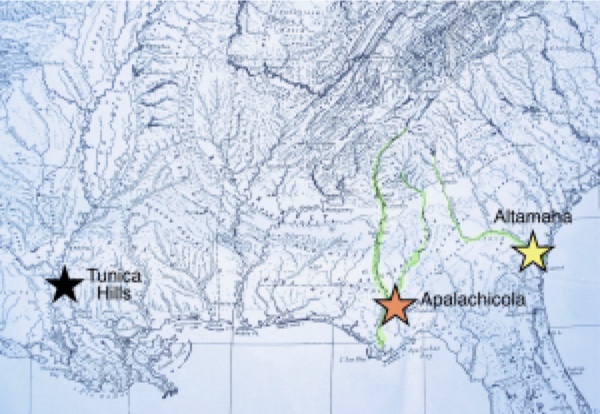
Indeed, it can be reasonably inferred that had this continent's geography lacked long-distance, southward-flowing rivers with banks of rich soil (contrasting to the predominant sandy soils of the region), North America would have lost to extinction genus Liriodendron (tuliptree) — as did Europe.
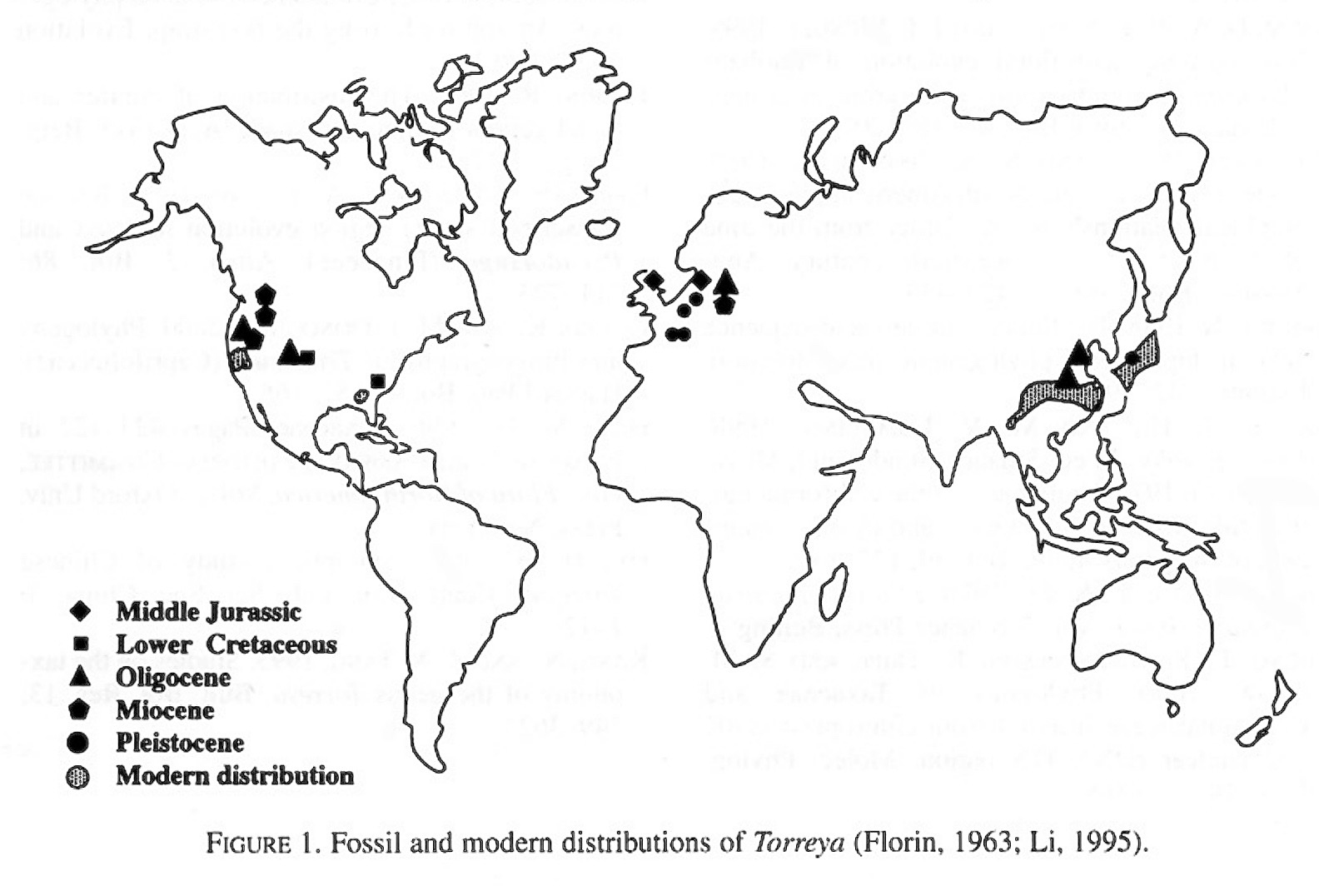
of Torreya
"... Our estimated time of divergence between Old World and New World Torreya species is ca. 30 million years ago (the early Oligocene). On the basis of the fossil record, Torreya does not appear in Asia until the Oligocene; migration from Europe to Asia might have been facilitated by the land connection created by the disappearance of the Turgai Sea. In Europe, Torreya populations are known to have existed up to the end of Pleistocene. Climatic cooling and glaciation in the Quaternary eliminated many plant groups from Europe, apparently including Torreya. The modern species are apparently young in age, and it will be necessary to integrate older fossils to ascertain the deeper biogeographic history of this genus."
"The taxon is an extremely rare conifer that once towered fifty feet above the forested ravines of the Apalachicola drainage system in northern Florida (Godfrey 1968, Foote and Jones 1994). An ancient genus of at least 160 million years old in age, species in the genus Torreya were widely distributed across the northern hemisphere during the Jurassic and Pliocene periods. Named for John Torrey, one of America's most distinguished botanists (1796-1883), this is one of the rarest native trees in the USA. Within its very limited range, it has become nearly extinct. There are no large trees left in its native habitats. What survives are a few scattered young saplings or suckers from root systems and bases of destroyed plants." [webpage accessed June 2021]
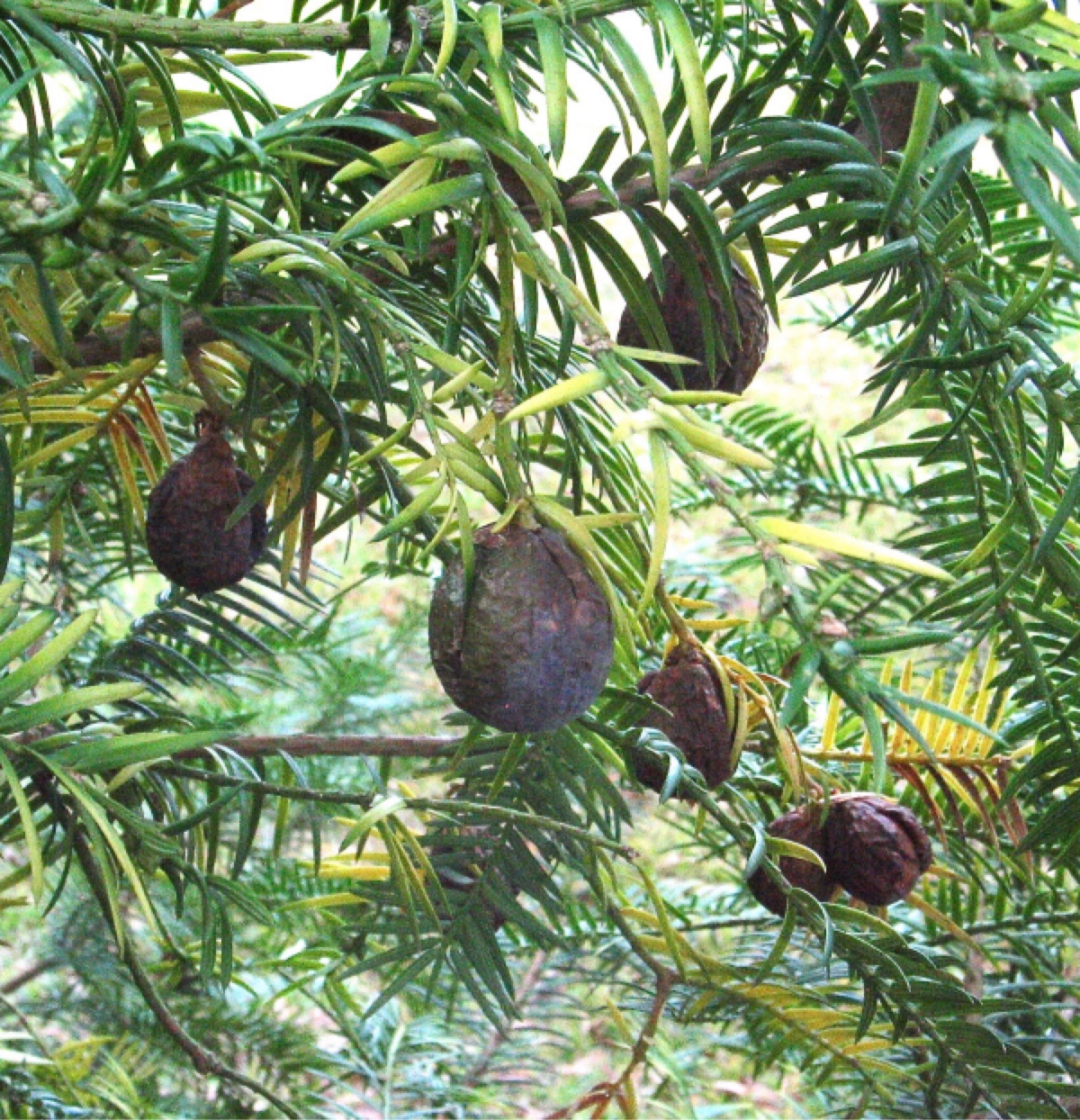


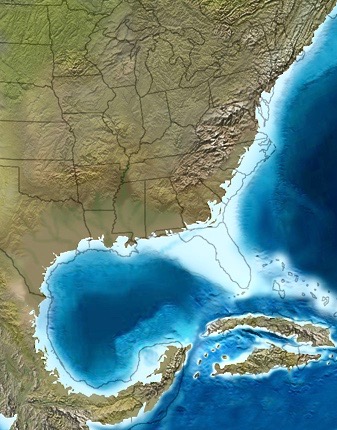

While it is true that the most recent fossil evidence of genus Torreya in eastern North America is Cretaceous and in the southern Appalachians, the presence of genus Torreya in Florida today does not imply that Florida has been its range throughout the Cenozoic.
"Research at botanical gardens will help to inform us as we make difficult decisions such as whether or when to undertake assisted migration to help species move to new suitable habitats. Species with present day southern ranges such as Torreya taxifolia and Magnolia ashei, which formerly inhabited the Great Smoky and Blue Ridge Mountains, are seemingly in the process of going extinct because they cannot migrate to suitable habitat as the climate warms. The Morris Arboretum [University of Pennsylvania] is growing and conducting research on Torreya and experimentally planting it in suitable habitats in the Great Smoky Mountains. Bill [William Cullina] noted that assisted migration is a controversial issue and much research is needed in this area." — Karen Hirschberg, 5 April 2023, "New England Botanical Society Meeting News", Rhodora
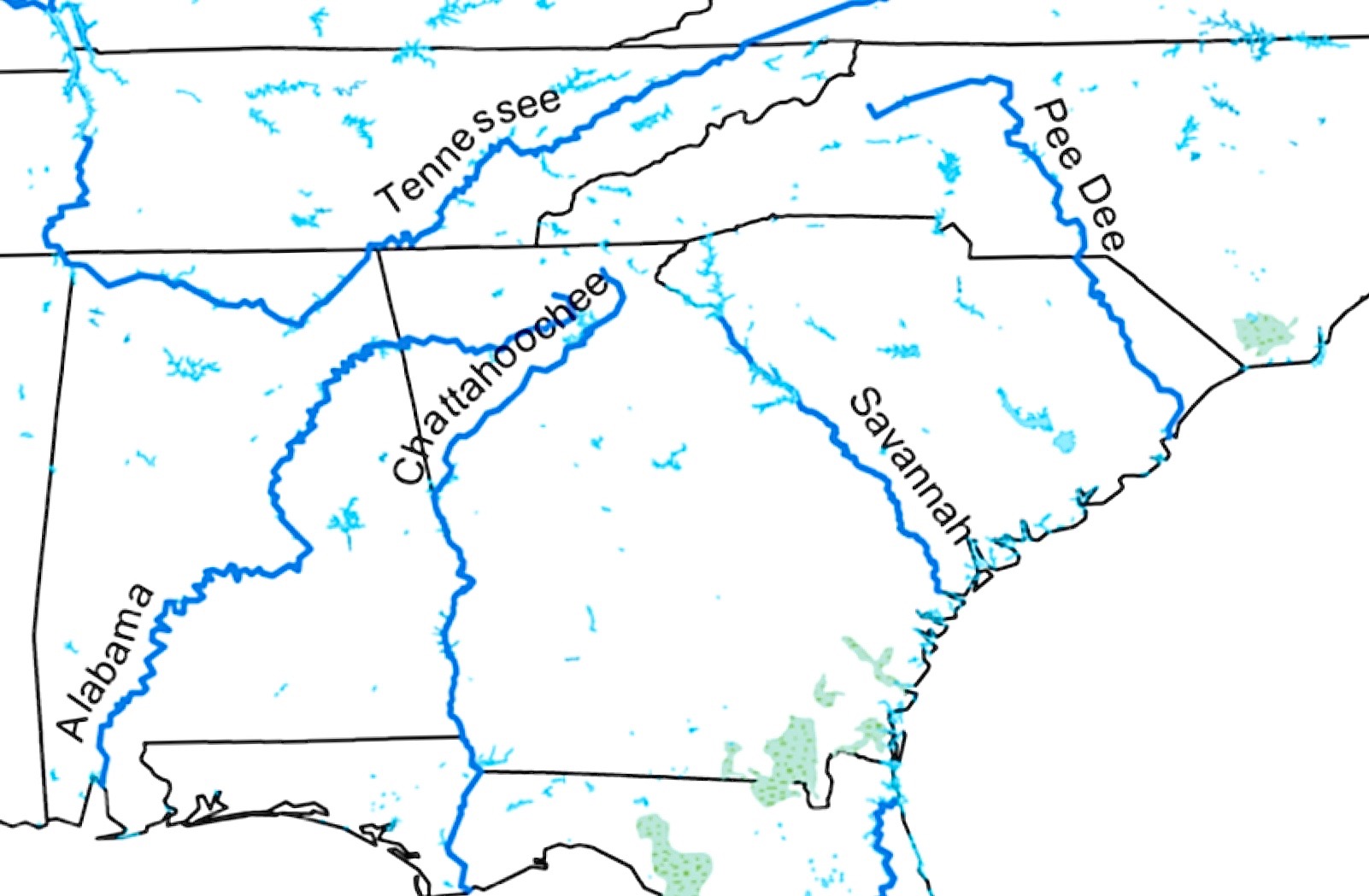
6B. An alternative hypothesis is that the large-seed of Torreya (which is sometimes capable of floating for several days) easily caught a fast and obstacle-free river ride southward from the Appalachian Mountains by way of the Chattahoochee River at the onset of cooling during the Pliocene or Pleistocene.
Barlow interprets: Surely, it is time to adapt the 20th-century "precautionary principle" in conservation ethics to handle our 21st century climate emergency conditions. For Torreya taxifolia that would entail far more than assisted migration pilot projects into the southern Appalachians. Field experiments also need to determine just how far north this species can tolerate now. Our own experiments in New Hampshire and Michigan, and especially seed-production in Cleveland, Ohio, offer early evidence that future-oriented conservation for this species would include these northward realms.
"An Assessment of Invasion Risk from Assisted Migration" by Jillian M. Mueller and Jessica J. Hellmann, Conservation Biology, 28 June 2007.
In 2018 Barlow launched a new webpage that aggregated the data and photos and summarized documentation of the northward long-ago horticultural plantings of Florida Torreya — none of which show any signs of "invading" their surrounds. That webpage is "Historic Groves of Torreya Trees: Long-term Experiments in Assisted Migration".
Finally, fellow Torreya Guardian (and caretaker of a dozen T. taxifolia seedlings on his NC property, elevation 3,800 feet) Russell Regnery emphasizes, until regulators start going after homeowners and nurseries that willy nilly plant just about anything anywhere, why single out the Torreya Guardian efforts in ways that incite the uninformed to call us eco-terrorists?
"... For T. tax, these two standards [#4, "Low Risk of Recipient Ecosystems," and #5, Barriers to Unassisted Migration] can best be evaluated in tandem. Here is where our own expertise comes into play (e.g., Martin 1957; Barlow 2001), as we search for an understanding of the near-time (15,000 years ago until the time of historical records) and deep-time story of genus Torreya. It is this attention to the past that leads us to regard assisted migration for T. tax to the southern Appalachians as not so much relocation for a plant struggling with global warming as repatriation of a once-native. It is thus a form of rewilding that uses a near-time or deep-time baseline for determining native range."
"It is pretty well accepted by participants in the American Chestnut recovery project that the primary reason that the American chestnut is thought of as a tree of
the mountains is that Phytopthora doesn't take freezing well. The
American Chestnut Foundation chapter checked my soil for presence/absence of Phytopthora before they let me plant my chestnut orchard. In fact, there are those who hypothesize that before the current forms of Phytopthora were introduced into North America (very early in colonial times) that the range of American Chestnut may have existed well into the Piedmont. Early introduction of Phytophthora may have played a part, too, in the demise of the wild population of Franklinia [along the Altamaha River]. So helping Torreya escape a freeze-intolerant pathogen (which I'm sure is well ensconced along the Apalachicola), is one more reason to consider assisted migration to save the species. No one, after all, can possibly control Phytopthora on an ecological scale [where climatic conditions enable it to thrive].
If evidence of Phytophthora water mold is found in the soil there, but if the plants are nonetheless able to withstand this pathogen, then such should be considered strong evidence that the southern Appalachians at rather high elevations are more amenable habitat than northern Florida for Torreya taxifolia in the current climatic regime.
Whether the Fusarium is native or exotic becomes a trivial question IF that same Fusarium species is present in any of the Historic Groves of Florida Torreya growing in North Carolina (especially the Biltmore grove and the Harbison House grove) but the cankers it causes that far north do not severely harm or kill the stems. All 5 of the papers co-authored by Jason Smith are linked and excerpted here. Note: Because the outcome of the invitation-only "Torreya Symposium" (organized in part by Jason Smith) yielded reports that indicated Fusarium torreyae as the certain cause of native-range stem dieback, and because the solution proffered was genetic engineering to insert fusarium-resistance into the Torreya genome, it is important for decision-makers (and reporters) to actually read the papers.
"Foster a working partnership between the Torreya Guardians, the Service, and other interested parties to help direct their managed relocation efforts." (p. 18)
So let us all combine our efforts to officially begin a multi-location and multi-phase pilot project for testing assisted migration of T. taxifolia. And let us do so in ways that demonstrate the positive benefits (both in data acquisition and economic efficiency) of having paid professionals and volunteer citizen naturalists combine their energy and assets.
We Torreya Guardians are branded as vigilantes, but helping Florida Torreya find its way northward into the mountains of North Carolina is pretty much like deciding where to go birdwatching to see Arctic Terns in January. Every amateur birder knows that the place to find Arctic Terns when it is cold and dark in the Arctic is to take a cruise to the Antarctic waters of the Southern Hemisphere. You won't find a single "Arctic" Tern in the Arctic during the Northern Hemisphere winter. They've
all gone fishing in the south polar seas. Similarly, Florida Torreya is no more native to Florida in today's climate regime than an Arctic Tern is native to the Arctic in January.
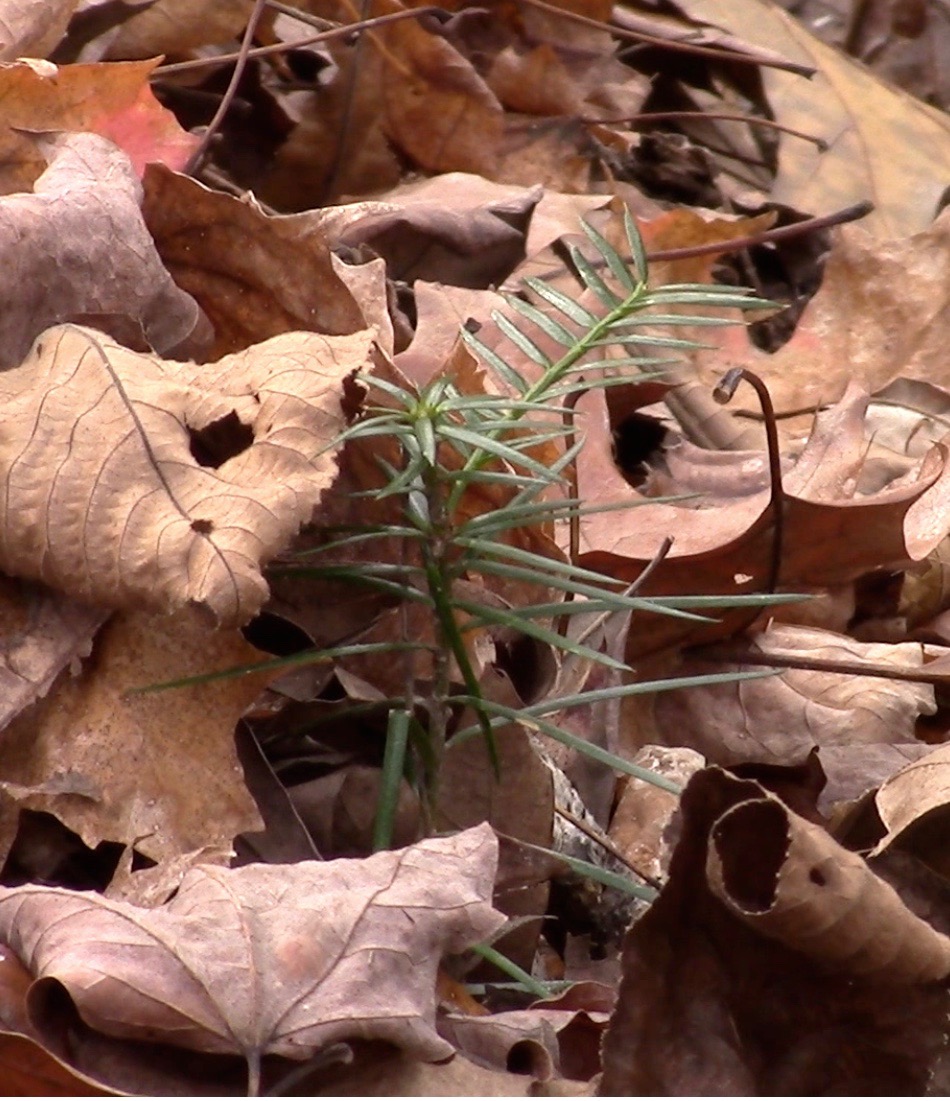

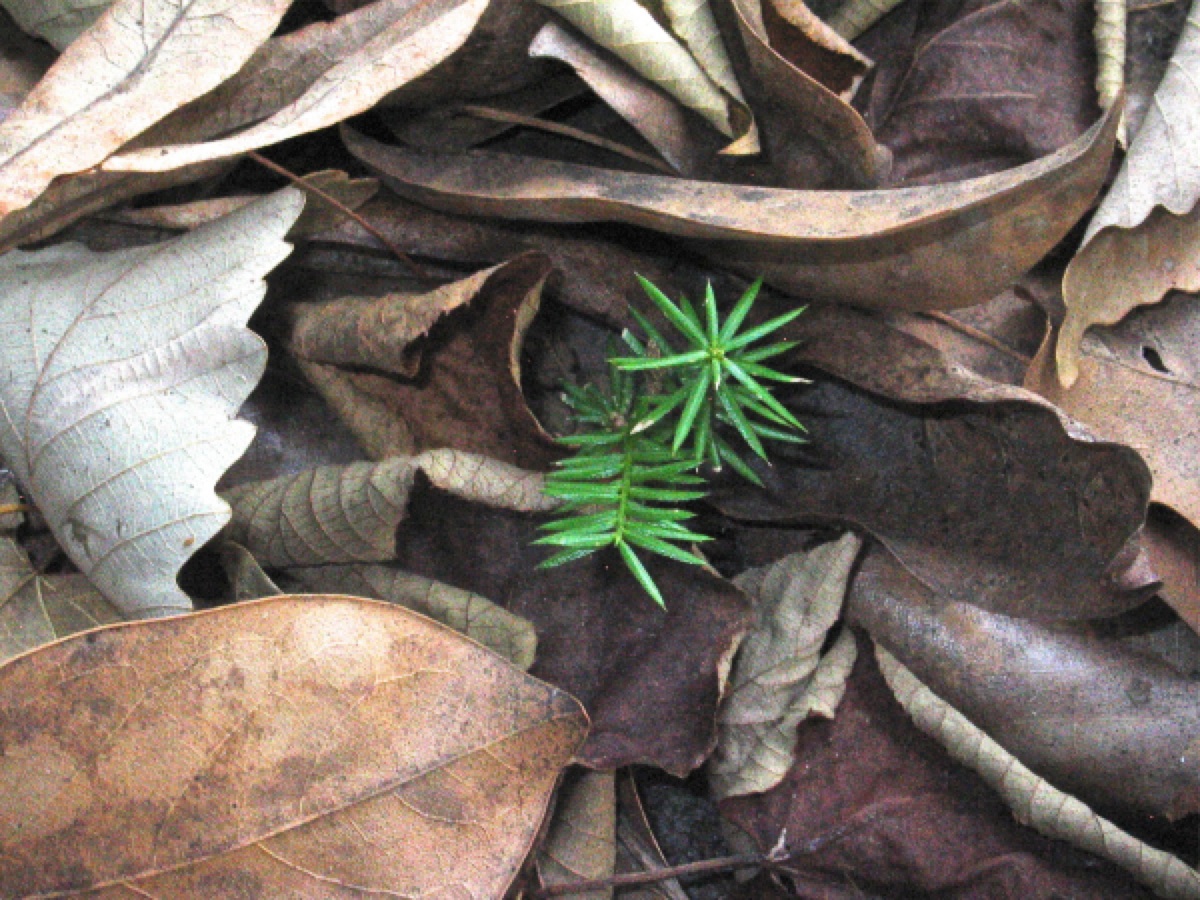
me to the realization that the future of the eastern deciduous forest is now at risk.
We can provide corridors to allow for species to migrate successfully
in the face of climate change. We may also need to be prepared to transplant
endangered species to new locations where climate will be favorable."
Forests in Peril (2002, pp 97, 207)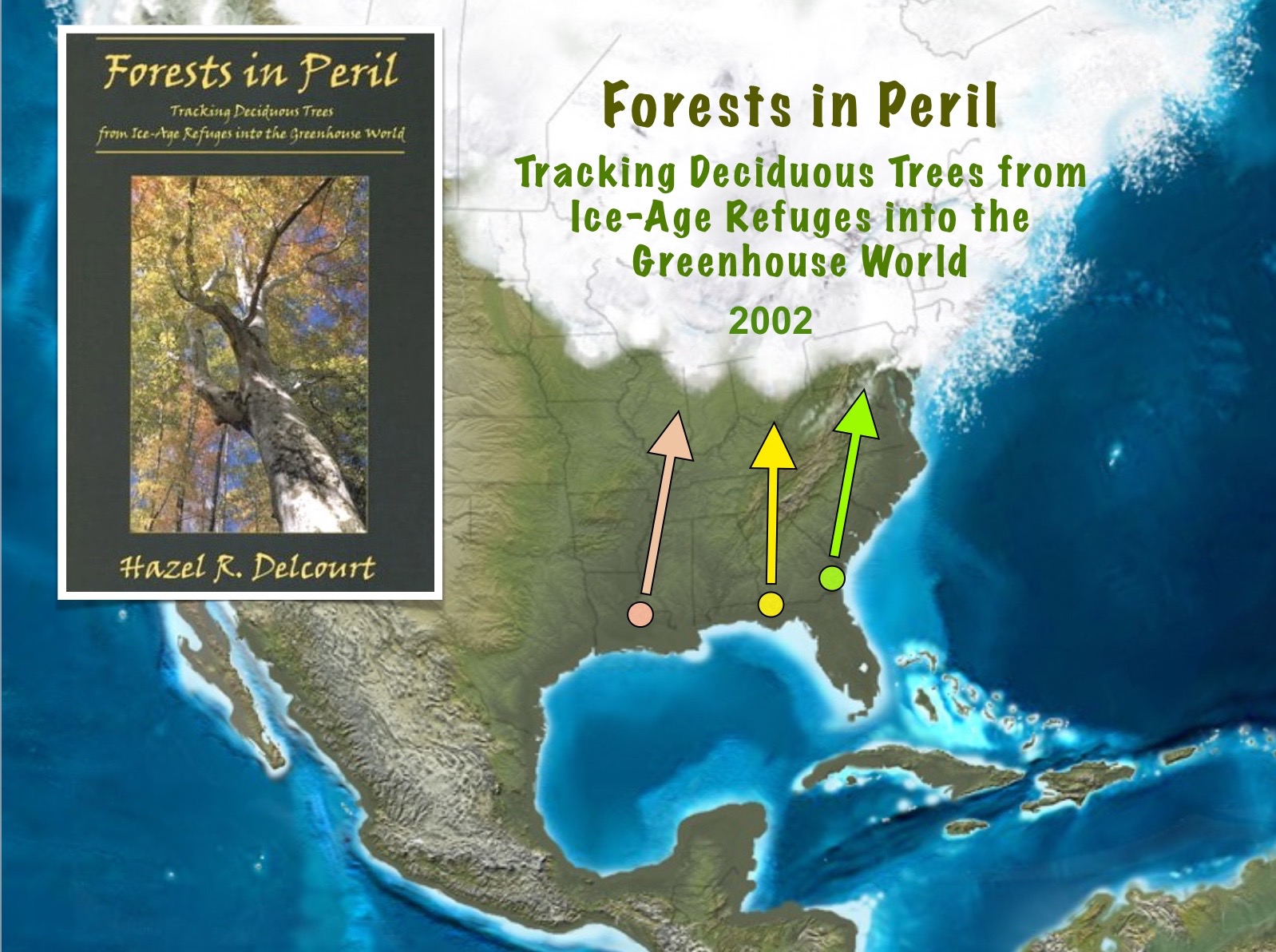
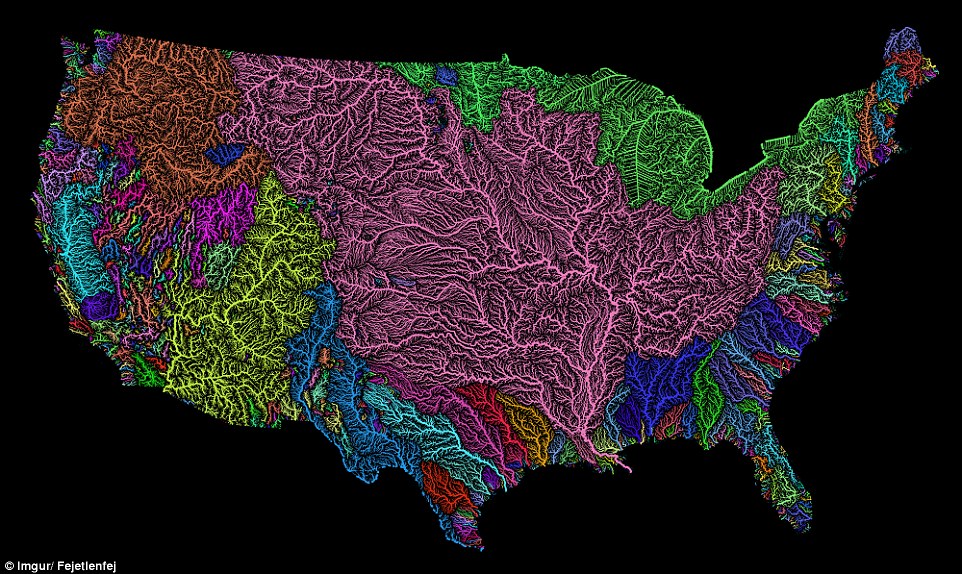
first plant a tree, and then see if the story is true. "
"You Are Brilliant, and the Earth is Hiring" (2009)
This webpage is cited in: